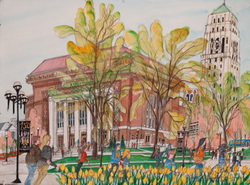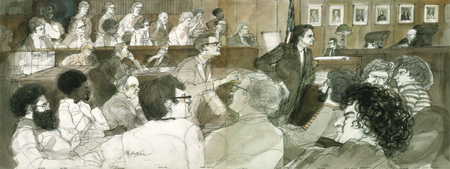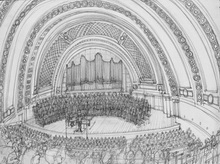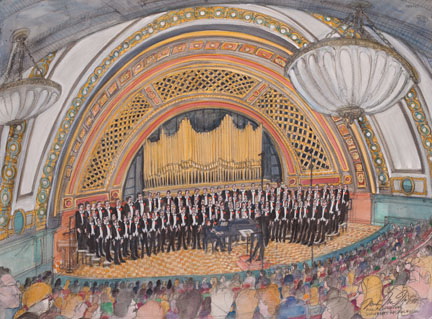
Here’s a great example of how an enterprising artist has built a thriving career for himself and is successfully using in-studio printing and materials from LexJet to make his own giclée reproductions.
The tension between the creative urge and the need to eat isn’t new. Michelangelo spent as much time lobbying the Pope and Medici families to fund his art projects as he did painting and sculpting. However, Lake Forest, IL-based artist Mark McMahon seems to have managed to balance the economic realities of this world with the demands of the creative muses. A veritable institution in the Chicago area, the entrepreneurially minded watercolor artist has embraced many different technologies to promote, replicate and sell his work. Like his father before him, McMahon isn’t shy about marketing matters. And when inkjet-based gicleé technology emerged, it was as if McMahon had been anticipating it for decades.
Mark is the son of Franklin McMahon, an internationally known artist/reporter who chronicled five decades of twentieth-century history in sketches and watercolors – particularly Civil Rights events, space race NASA and presidential campaigns. Among other famous events in the elder McMahon’s portfolio is the 1960 Nixon Kennedy debate and the 1955 Emmett Till murder trial. On the wall near Mark McMahon’s fireplace is a reproduction of one of his father’s paintings of the 1969 Chicago Seven conspiracy trial.

In some ways, this print represents the culmination of McMahon’s technological evolution over the years, as he explored methods that would allow him to increase his income while maintaining artistic integrity and pleasing his customers. Both he and his father have digitized thousands of their works and licensed them to Corbis.
A Means of Increasing Saleable Production: Just as Michelangelo and his contemporaries maintained workshops in which gifted students produced reproductions for sale (it may have been the Renaissance, but branding was already alive and well), Mark McMahon began to experiment early in his career with ways to increase his saleable production.
Just out of art school in 1972 and settling into his two preferred genres—landscapes and cityscapes—Mark began reproducing his original black-and-white line drawings on an offset press. Hand coloring each drawing, he sold hundreds of Chicago cityscapes to the Marshall Fields gallery on State Street.
He then moved to reproducing the drawings on a screen-printing press, this time directly onto Arches watercolor paper. This technique allowed him to produce a hybrid limited-edition run in which each copy was individually painted, adding to the value without requiring a new drawing for each one. Once he began selling these limited editions to local galleries such as Billy Hork and Merrill Chase, his reputation began to build and Mark began searching for new media to feature his artistic output.
“With the prices for my paintings beginning to rise, I began looking for other types of media that could feature my work,” says Mark. “I realized that I could silk screen the drawings onto ceramic tile, hand color and glaze those and create a whole new medium for myself, which led to nine ceramic murals at Chicago’s O’Hare airport.”
Mark quickly realized these tiles could be combined to create large-scale “montage” murals, which soon begin appearing in public spaces in Chicago and eventually, around the world. Today the city by the lake boasts dozens of large scale tiled cityscape murals at locations such as the venerable Union League Club, the intersection of Van Buren/Federal Streets and Lake Forest High School library.
McMahon traces the beginning of his digital odyssey to a chance meeting in Lost Dunes Golf Club in Michigan in 2000. Mark was painting a landscape commission for an architect when a local gicleé printer passed by and saw McMahon’s work in progress. He encouraged McMahon to try outputting his work on the IRIS printer, an early large-format inkjet printer remembered for its beautiful output and sporadic behavior. Soon, Mark was selling on-demand prints of Harbor Country scenes to the dozens of tourist galleries in southeastern Michigan.
Marketing Success Based on Good Old-Fashioned Hard Work: If you talk to McMahon, you’ll discover that a lot of his success is due to good old-fashioned hard work. Wherever his artwork appears in galleries around the country, chances are he packed his car up with paintings, prints and drawings and visited the locations himself.
“My father always said that artists should leave their studios and go out into the world,” says Mark. “That applies to marketing as well.”
As he became comfortable outputting his pieces on the IRIS, Mark was able to tailor pricing to galleries to meet their requirements, offering discounts for quantity orders. However, it wasn’t long before he realized he could also benefit economically by printing his works himself.
Creating His Own Reproductions: With plenty of expert help from LexJet, Mark purchased a 24-in. Epson 7600 along with Photoshop’s Elements software and a supply of Sunset Textured Fine Art paper. “I like the German Etching Paper for some pieces,” says McMahon, “But for most prints I prefer the Sunset. It’s a little more flexible and a little more forgiving.”
 McMahon’s typical art-to-print process can be summarized in one of his recent projects, a series of prints celebrating the 150th anniversary of the University Michigan Glee Club. First, Mark went to Ann Arbor and attended the event in person, making sketches of key moments at the concert event and celebration. Later, in his studio, he painted watercolors using the drawings.To digitize the new set of originals, he photographed them in sections using a Canon EOS 5D Mark II, then splices the digital files together seamlessly using Adobe’s Photoshop Elements Photomerge Panorama utility. He then prints directly to the Epson from Elements.
McMahon’s typical art-to-print process can be summarized in one of his recent projects, a series of prints celebrating the 150th anniversary of the University Michigan Glee Club. First, Mark went to Ann Arbor and attended the event in person, making sketches of key moments at the concert event and celebration. Later, in his studio, he painted watercolors using the drawings.To digitize the new set of originals, he photographed them in sections using a Canon EOS 5D Mark II, then splices the digital files together seamlessly using Adobe’s Photoshop Elements Photomerge Panorama utility. He then prints directly to the Epson from Elements.

With a four-decade art career behind him, Mark McMahon shows no signs of slowing down. He embraces his success but shows no signs of taking it for granted. “Some of my originals might sell for five figures these days,” explains McMahon, “But not everyone is in that market. So I plan to continue to come up with a lot of different ways that people can afford to buy my art. The inkjet gicleé prints are entirely consistent with the principles I’ve always followed: On the one hand you have the art you love to create. When it’s finished, you move it into the process, which allows you to make a living and maintain your freedom.”
To see more examples of his work, visit www.mcmahonartgallery.com
